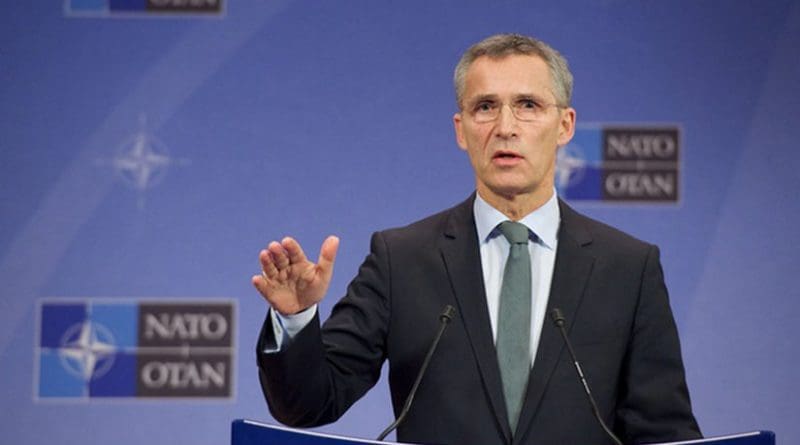NATO Ministers Agree To Upgrade Command Structure Amid Tensions With Russia
By RFE RL
(RFE/RL) — NATO defense ministers have endorsed a plan to establish two new military headquarters designed to improve the movement of troops across the Atlantic and within Europe, as the alliance looks to counter the growing threat from Russia.
NATO Secretary-General Jens Stoltenberg made the announcement on November 8, the day before an expected decision to boost NATO’s mission in Afghanistan by some 3,000 troops.
Speaking after the ministers’ first day of meetings during the November 8-9 gathering in Brussels, Stoltenberg provided initial details on the two new commands, although he said military commanders would “flesh out the details” and present them to defense ministers in February 2018.
It is the first time the 29-member alliance is expanding its command structure since the end of the Cold War, when 22,000 personnel were working at 33 commands. Numbers have been slashed since to fewer than 7,000 people and seven commands.
In recent years, Russia’s military actions in Ukraine have increased concerns about Moscow’s intentions in NATO nations, particularly former Soviet republics or Warsaw Pact satellites of the Soviet Union.
Russia occupied and seized Ukraine’s Crimean Peninsula in March 2014 and backs separatists whose war against Kyiv’s forces has killed more than 10,000 people in eastern Ukraine since April of that year.
Aggressive Maneuvers
A series of potentially dangerous close encounters between Russian and NATO warplanes and navy ships in recent months has added to the tension, with the alliance accusing Moscow of aggressive maneuvers in the air and at sea.
Those actions have prompted NATO to step up its defenses in the east, deploying four multinational battle groups in the three Baltic states and Poland — totaling approximately 4,500 troops.
One of the planned new NATO command centers will be tasked with ensuring that “sea lines of communication” between North America and Europe “remain free and secure,” Stoltenberg said.
The other command will “improve the movement of military forces across Europe” and strengthen logistical functions across NATO.
“This is vital for our transatlantic alliance,” Stoltenberg told reporters. “It is about how to move forces across the Atlantic and how to move forces across Europe.”
“The adaptation of the NATO command structure will further strengthen our ability to reinforce allies quickly and effectively,” he added.
Stoltenberg said any new command must ensure that legislation easing the transportation of troops and equipment across various national borders is fully implemented.
The secretary-general also said that coordination with the private sector must be in place to guarantee the availability of sufficient transport capacity.
“And we need to improve infrastructure, such as roads, bridges, railways, runways, and ports. So NATO is now updating the military requirements for civilian infrastructure,” he added.
Locations To Be Decided
Diplomats said no decisions have been made on location for the two new command centers, although Germany has expressed interest in hosting the logistics base, arguing its location in Central Europe would make it the strongest candidate.
The diplomats also said Portugal, Spain, France, and the United States could be potential hosts for the new Atlantic sea command.
He said NATO defense ministers also agreed on the creation of a new Cyberoperations Center to strengthen cyberdefenses and help integrate cybercapabilities into NATO planning and operations at all levels.
The move follows a series of global cyberattacks that disrupted multinational firms, ports, and public services this year.
“We must be just as effective in the cyberdomain as we are on land, at sea, and in the air, with real-time understanding of the threats we face and the ability to respond however and whenever we choose,” Stoltenberg said.
Afghan Strategy
On the second day of their meeting in Brussels on November 9, the NATO ministers are expected to decide to increase the number of troops in Afghanistan from the current 13,000 to 16,000 to aid the Kabul government in its fight against the Taliban and other extremist groups.
Speaking ahead of the gathering, Stoltenberg said the new troops would not have combat roles but would be part of NATO’s “train, advise, and assist” mission, Resolute Support, and that about half of the additional troops will come from the United States.
U.S. President Donald Trump in August announced a new Afghan strategy. In September, U.S. Defense Secretary Jim Mattis said that more than 3,000 additional U.S. troops will be deployed to Afghanistan.
“The United States is already deploying more troops, and many other allies and partners are making additional commitments to continue to strengthen the Afghan forces so that they can fight international terrorists. And pave the way for a lasting political solution,” Stoltenberg said.
The United States led an invasion to drive Taliban extremists from power after Al-Qaeda militants whose leaders were sheltering in Afghanistan carried out the September 11, 2001, attacks on the United States.
Militant Resurgence
The United States, NATO, and other partners had more than 100,000 troops in Afghanistan for a time, but the Taliban has been resurgent since NATO ended combat operations in 2014. The extremist group Islamic State (IS) has also stepped up attacks.
The defense ministers’ meeting is also set to agree on a new plan to improve the way the alliance commands and deploys its forces, Stoltenberg said.
The alliance needs a command structure to ensure “we have the right forces, in the right place, with the right equipment at the right time,” he said.
The meeting will endorse a plan to create two new commands — one to protect sea lanes ferrying troops and equipment across the Atlantic, the other for land forces in Europe.
It’s the first time the 29-member alliance is expanding its command structure since the end of the Cold War, when 22,000 personnel were working at 33 commands. Numbers have been slashed since to fewer than 7,000 people and seven commands.
North Korea’s nulcear ambitions will also be on the agenda.

